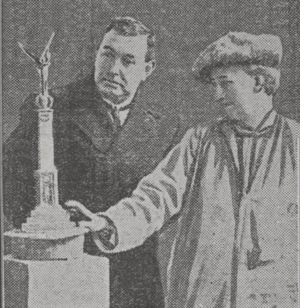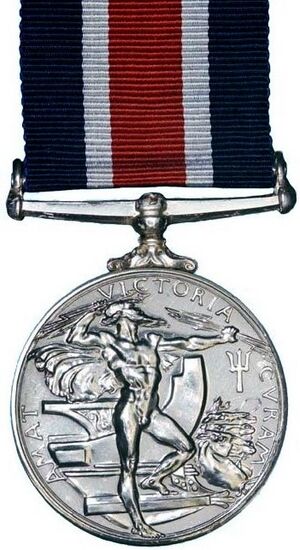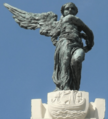Margaret Winser facts for kids
Margaret Winser (1868 – 29 December 1944) was a talented English artist. She was a sculptor, someone who designed medals, and an art teacher. She is best known for creating the Hastings War Memorial and designing important military medals.
Contents
Margaret Winser's Life and Art
Margaret Winser was born in 1868 in a place called Rolvenden in Kent, England. Her father, Albert Winser, was a farmer.
She started working as an assistant art teacher around 1891. Margaret also studied at the Dover School of Art. There, she won several national awards for her artistic skills. At one point, she even studied with the famous sculptor Auguste Rodin.
Designing Military Medals
In 1904, the Royal Mint (which makes coins and medals) asked students to design a new medal. This medal was for the Naval Good Shooting Medal, given to sailors who were excellent at shooting. Margaret Winser's design was chosen!
Her design showed a powerful image of a warship firing its guns. Even though this specific medal was stopped in 1914, her design is still used today. It can be seen on the Queen's Medal for Champion Shots for both the Royal Navy and the New Zealand Naval Forces.
Margaret Winser also designed the back of another important medal. This was the Naval General Service Medal. It was created in 1915 and given to Royal Navy members for smaller military actions until 1962.
Creating the Hastings War Memorial
After the First World War, many towns wanted to build memorials. These memorials would remember the brave soldiers, sailors, and airmen who had died. Margaret Winser was chosen to design the War Memorial for Hastings and St Leonards.
This memorial is in Alexandra Park in Hastings. It features a bronze statue of a winged figure, representing victory. There are also three bronze panels. These panels show soldiers, sailors, and airmen during their service. The memorial was officially opened on March 26, 1922.
Margaret also designed a memorial for 17 lifeboatmen. They had drowned in the 1928 Rye lifeboat disaster. The families of the men liked her design, but it was not used in the end.
Working with Ellen Terry
Smallhythe Place is a historic house near Tenterden. The famous actress Dame Ellen Terry bought it in 1899. It became her main home later in her life. Margaret Winser lived nearby and often visited Ellen Terry.
In 1913, Margaret created a plaster medallion (a round piece of art) of Ellen Terry. When Dame Ellen Terry passed away in 1928, Margaret was invited to her home. She made a special mould of Ellen Terry's face. From this mould, she created four "death masks." These masks are copies of a person's face after they have died.
Two of these masks are still at Smallhythe Place today. One was given to the Royal Shakespeare Theatre in 1933. The fourth mask was given to the National Portrait Gallery in London in 1949. Margaret also made two plaster casts of Ellen Terry's hands. She then used these casts to create a bust (a sculpture of the head and shoulders) of the actress.
Today, the medallion, a death mask, and the bust of Ellen Terry are part of the collection at Smallhythe Place. This house is now a museum run by the National Trust.
Other Artistic Creations
Throughout her career, Margaret Winser made many other artworks. These included memorial plaques, statues, and portrait medallions. A medallion is a small, round piece of art, often with a portrait on it. She even made one of the famous violinist Joseph Joachim.
From 1904 to 1929, she often showed her sculptures at the Royal Academy in London. This is a very important art institution. She was also considered for a big art exhibition in London in 1908.
Margaret also helped illustrate a book called 'Lays and Legends of the Weald of Kent'. Her sister, Lilian Winser, wrote this book, which was published in 1897.
Margaret Winser lived near Tenterden in Kent for most of her life. She passed away on December 29, 1944, at the age of 76.
Examples of Winser's Work
These are examples of her drawing and sculpture.
-
Bust of Ellen Terry, Smallhythe Place, Kent








